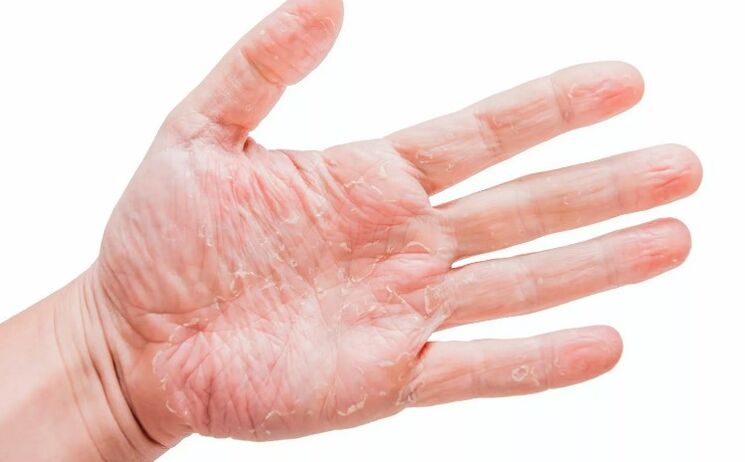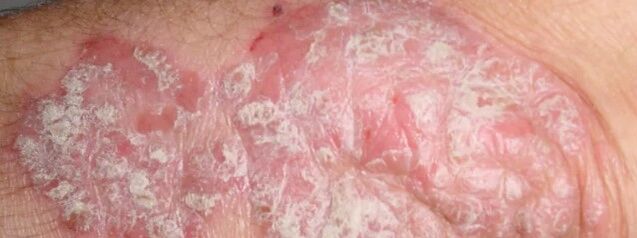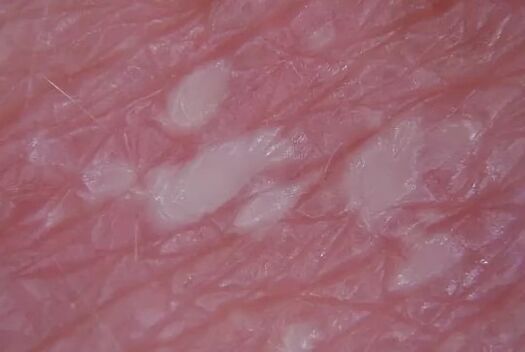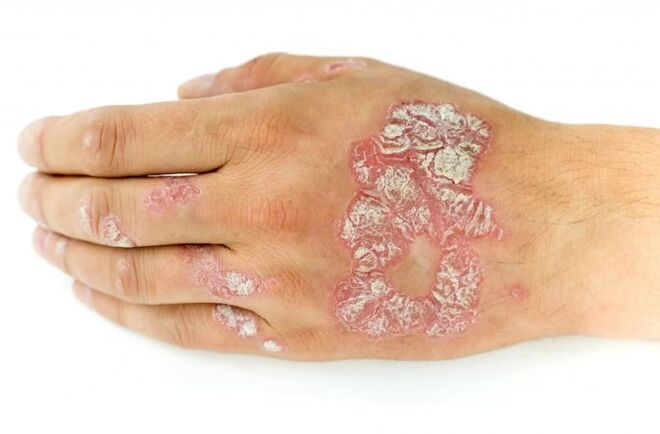Psoriasis is a chronic dermatological disease, the basis of the pathogenesis of which is the rapid abnormal growth of the skin cells, which leads to the appearance of the skin of areas compacted in different colors.
Today, psoriasis has become the most common non -infectious dermatological disease.Psoriasis does not have a gender predisposition - men and women suffer from them equally.You can get this pathology at any age, but most often the first signs of the disease appear up to 20 years.

Psoriasis is quite poor in therapy, partly due to the fact that so far the etiology and pathogenesis of this pathology are not yet clear.Moreover, there is no means of specific prevention of psoriasis, as it is impossible to determine whether a person has a predisposition to the disease.
The reasons for the development
At the moment, scientists cannot answer without hesitation the question "Why is psoriasis developing?"Two key factors of the development of the disease are distinguished - this is a genetic predisposition and hyperreactivity of the immune system.
Has been created so far thanPredisposition to the development of psoriasis has been inherited.But the difficulty lies in the fact that it is extremely difficult to track how exactly this predisposition is inherited and after the influence which factors can develop psoriasis.
It is believed that the following factors can cause the development of psoriasis:
- Frequent skin hypothermia as well as the effect of dry climate on it;
- Infectious processes;
- Frequent stresses;
- The use of several groups of pharmaceuticals: non -steroidal anti -inflammatory drugs (especially aspirin), some hypotonic and psychotropic drugs;
Pathogenesis
At the moment, the pathogenesis of psoriasis has not been finally clarified.Two main connections of pathogenesis can be distinguished:
- Violation of skin keratinization.
- Dismissal of the immune system.
Together, the above factors lead to the fact that the lower layer cells of the epidermis for an unknown reason begin to share very quickly.This process leads to a reactive increase in the ladder of the upper layer of epidermal cells, which is externally manifested by skin peeling.
Symptoms
The disease always begins acutely, with no harbingers of developing the pathological process.As a rule, the first redness elements are located in the place where the skin was damaged.
At the beginning of the symptoms of psoriasis, the papules of pink or red color appear on the skin.This process is accompanied by itching.The size of the elements ranges from a few millimeters to 1.5 centimeters (in some cases, the elements also reach large sizes).Then the frying elements are covered with easily separated silver scales.
Sometimes psoriasis damages nail plates.This pathology resembles fungal damage to the nails and is manifested by the following symptoms:
- There are many small breaks on the surface of the nail;
- The edge of the nail plate thickens and acquires a dull, yellow color;

Another characteristic manifestation of psoriasis is psoriatic arthritis (symmetrical damage to the joints and periarticular tissue).Most often, the pathological process takes place in the interpreted joints of the feet and hands.At first, the disease is manifested by pain and swelling, and then deformation of the affected joint develops, which can even lead to the patient's disability.It should be noted that in rare cases, damage is also possible.Sometimes psoriatic arthritis also develops in the joints of the spinal column.
The types
The following types of psoriasis are distinguished depending on the severity and traits of clinical manifestations:
- Tiles.This type is the most common - is diagnosed in almost 90% of people suffering from psoriasis.Elements of redness, theoretically, can occur in any area of the skin.However, the most typical localizations are the lower part of the back, scalp and extensors of the upper and lower extremities (elbow and knee area).It should be noted that with this form of psoriasis, pathological elements do not appear on the face, palms and heel remain intact.From the outside, this shape looks like an inflamed plate covered with silver with scales.When the plates appear from under the scales, the lymph is released.With further damage, the plaque begins to bleed.The shape of the psoriasis plaque is also characterized by the appearance of so -called "paraffin lakes" - joining some tiles into one element.
- Reverse psoriasis (psoriasis of flexion surfaces or interigonic).This form is quite rare.The redness elements have the shape of red peel spots, which do not last on the surface of the skin intact.Typical localization of this form of psoriasis - skin folds (axillary cavities, inguinal folds, skin under the chest in women).Also, due to localization characteristics, a fungus infection often joins with reverse psoriasis.
- Genital psoriasis.This form most often develops in girls, mainly in adolescence (up to 16 years).Often the development of the pathological process is preceded by streptococcal infection (for example, angina).Reds with a rocky psoriasis resemble an ordinary allergic rash - small spots that have a gray to the lilac, not elongated on the surface of the skin.Such rashes can appear in any area of the skin.The skin on which the rashes are, as a rule, has an inflamed appearance.
- Pustulenia psoriasis.It is a heavier form than the above.With pustular psoriasis, small painful pus pus filled in the patient's body.This form can occur both locally and in general.With pustular psoriasis, the general condition of patients often worsens, body temperature rises.With the generalized form of pustular psoriasis, hospitalization is needed.
- Erytroderma is the most severe form of psoriasis.With it, almost all the patient's skin is damaged.This form is associated with chills, an increase in body temperature in high numbers, a sharp deterioration in the patient's condition.This disease requires urgent medical intervention, in the absence of which a fatal outcome can even occur.

rigor
There are many different gradations of psoriasis in terms of severity.However, in clinical routine practice, the simplest of them is most often used, which does not require any particular search method.
Thus, distinguishThree degrees of severity of psoriasisDepending on the spread of the pathological process:
- Easy form.This form is established in cases where the patient is affected by psoriasis less than 3% of the skin.
- Moderate form.This diagnosis is made with damage to psoriasis from 3 to 10% of the patient's skin.
- Severe form.This form is exposed taking into account the skin lesion and clinical manifestations.Thus, this form is exposed with a lesion of more than 10% of the skin or with a significant deterioration in the patient's well -being.It should be noted that psoriasis is considered severe in the presence of psoriatic arthritis, regardless of the extent of the spread of the pathological process.
The course of illness and prognosis
Psoriasis is a disease with a wave -like course, that is, it has periods of forgiveness (when symptoms practically disappear) and irritation.As a rule, the process has deteriorated during the season periods.
The prognosis for psoriasis depends on the form of the disease and severity.As a rule, with classic forms of psoriasis, the prognosis is favorable, but in severe forms, disability is possible and even death.
Despite the favorable prognosis in most forms of psoriasis, do not forget about the social aspect of this disease.In the acute period of the disease, the skin and hair part of the human head are covered with cortex plaques, which is often perceived by others as a manifestation of any contagious disease.Because of this, those around them begin to avoid the patient, which makes him closed, and often depressed.
Troubleshooting

The basis of diagnosis is clinical manifestations of the disease, features of its current, as well as objective inspection data.There are a number of characteristic symptoms that are determined for the diagnosis of psoriasis:
- "Psoriatic film" - if you clean the surface of the peel papule, then it becomes smooth and shiny.
- "Stein Stain" - when psoriatic elements appear, their surface appears, Starin films appear.
- "Blood coating" - if, after manifesting the above symptoms, do not stop the hobbies of the elements, then their surface is covered with blood drops (capillary bleeding appears).
The three symptoms described above are called "psoriatic trio" and are the main method of diagnosing psoriasis.However, there are some other signs that are defined in a given stage of the disease:
- In the acute phase of psoriasis, the symptoms of Pilnov are caused (psoriatic elements are surrounded by a red edge) and kebner (new rashes are actively appearing in damaged areas of the skin).
- The stages of regression also determine the symptom of Voronov (around the elements defines an excellent edge of the light of a small wrinkled skin).
From laboratory and instrumental methods, they are used below:
- Microscopy of scales and dough with potassium hydroxide (for differential diagnosis with fungal skin damage).
- In complex clinical cases, with an atypical course, pathological elements are directed to performing a biopsy.
- With psoriatic arthritis, blood test indicators are examined (mainly ESR and rheumatoid factor) and perform an X -Ray of affected joints (for differential diagnosis with arthritis of another etiology).

Treatment
Treatment of psoriasis is a long and complex process.Unfortunately, as psoriasis is a chronic disease, the purpose of therapy is not to cure the patient, but to achieve prolonged remission and prevent irritation.Treatment depends on the phase, shape and severity of psoriasis.It should be noted that a series of medical measures should be prescribed by a dermatologist and only after a thorough examination of the patient and verification of the diagnosis.
Diet Psoriasis treatment should begin with correcting the patient's daily diet.If we talk about general recommendations, then people with psoriasis should reduce the amount of protein in the diet and increase the amount of carbohydrates due to the consumption of vegetables and fruits.It is also necessary to exclude those products that can provoke deterioration of psoriasis: alcohol, chocolate, various spicy spices, as well as limit the use of garlic and onions.It is also worth limiting the consumption of fried meat and fish, smoked meat.
Also, when compiling an optimal diet, the patient's predisposition to allergies to any product and, if possible, exclude them should be considered.The optimal diet is the use of a large amount of fresh vegetables and lean vegetables and varieties of boiled meat and fish.
Drug treatment.For the treatment of psoriasis, pharmaceuticals are used in various forms of release: ointments, tablets, injections, etc.
In addition to local medicines, system therapy is also used when medicines are prescribed in the form of tablets or injections.The following drugs are most often prescribed:
- Immunosuppressants.They have an overwhelming effect on the immune system.It is described only in severe cases that are not suitable for other methods of therapy, as there are a large number of side effects and is difficult to transfer.
- Cytostatics.Its action is aimed at reducing the rate of cell division, which leads to a decrease in the degree of development of psoriasis and a decrease in peel.It is used only in very severe cases, resistant to other methods of therapy.
- Various homeopathic drugs.Unfortunately, these medicines are not suitable for all patients and do not always have the necessary effect.

Photochemotherapy.Lighting is one of the main methods of psoriasis therapy.
In conclusion, it is worth noting that psoriasis is a complex and not fully studied disease.A qualified doctor should be done with treatment.Remember that no wonderful internet method will help you save psoriasis yourself.
The same can be said about the popular medicine - all its methods will only benefit in combination with the basic remedies that the doctor participating in.
Thus, we can conclude that in order to succeed in treatment, the patient should only use those methods he agrees with his follow -up physician, as well as observe all his recommendations.This is the only way to achieve good success in prolonged treatment and remission of psoriasis.























